Solar eclipse of August 31, 1932
| Solar eclipse of August 31, 1932 | |
|---|---|
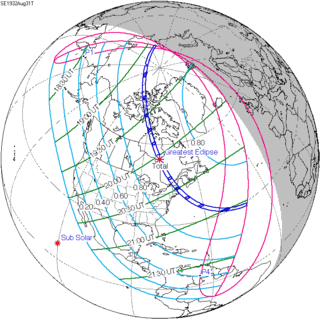 Map | |
| Type of eclipse | |
| Nature | Total |
| Gamma | 0.8307 |
| Magnitude | 1.0257 |
| Maximum eclipse | |
| Duration | 105 sec (1 m 45 s) |
| Coordinates | 54°30′N 79°30′W / 54.5°N 79.5°W |
| Max. width of band | 155 km (96 mi) |
| Times (UTC) | |
| Greatest eclipse | 20:03:41 |
| References | |
| Saros | 124 (50 of 73) |
| Catalog # (SE5000) | 9357 |
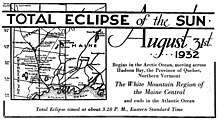
A total solar eclipse occurred on August 31, 1932. A solar eclipse occurs when the Moon passes between Earth and the Sun, thereby totally or partly obscuring the image of the Sun for a viewer on Earth. A total solar eclipse occurs when the Moon's apparent diameter is larger than the Sun's, blocking all direct sunlight, turning day into darkness. Totality occurs in a narrow path across Earth's surface, with the partial solar eclipse visible over a surrounding region thousands of kilometres wide. Totality was visible from Northwest Territories (today's Northwest Territories and Nunavut) and Quebec in Canada, and northeastern Vermont, New Hampshire, southwestern Maine, northeastern tip of Massachusetts and northeastern Cape Cod in United States.
Related eclipses
Solar eclipses 1931-1935
This eclipse is a member of a semester series. An eclipse in a semester series of solar eclipses repeats approximately every 177 days and 4 hours (a semester) at alternating nodes of the Moon's orbit.[1]
| Solar eclipse series sets from 1931-1935 | |||||
|---|---|---|---|---|---|
| Descending node | Ascending node | ||||
| 114 | September 12, 1931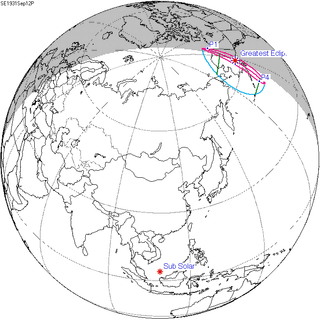 Partial |
119 | March 7, 1932 Annular | ||
| 124 | August 31, 1932 Total |
129 | February 24, 1933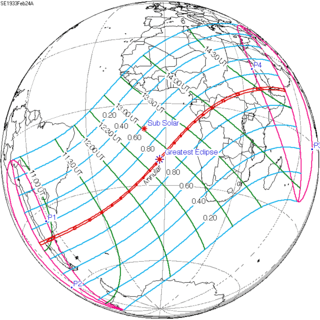 Annular | ||
| 134 | August 21, 1933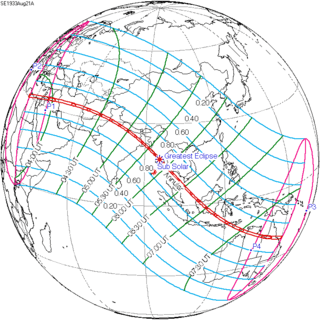 Annular |
139 | February 14, 1934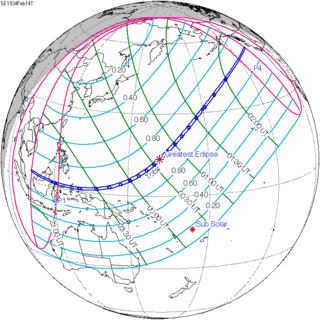 Total | ||
| 144 | August 10, 1934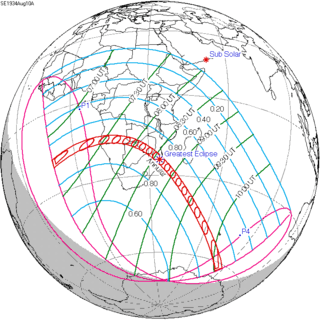 Annular |
149 | February 3, 1935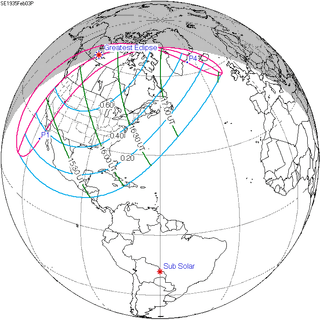 Partial | ||
| 154 | July 30, 1935 Partial | ||||
Notes
- ↑ van Gent, R.H. "Solar- and Lunar-Eclipse Predictions from Antiquity to the Present". A Catalogue of Eclipse Cycles. Utrecht University. Retrieved 6 October 2018.
References
- Earth visibility chart and eclipse statistics Eclipse Predictions by Fred Espenak, NASA/GSFC
| Wikimedia Commons has media related to Solar eclipse of 1932 August 31. |
